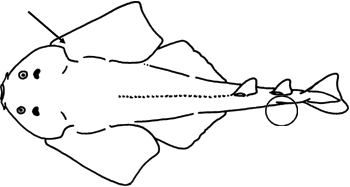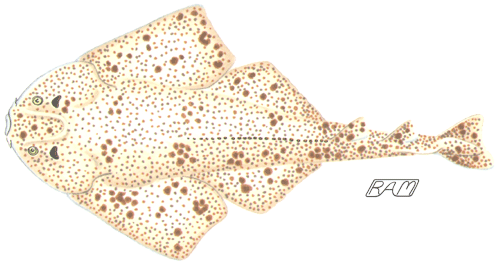Guide to Shark Identification
Order Squatiniformes — Angel Sharks
All angel sharks are inhabitants of sandy or muddy plains, often in the deep-sea or adjacent to shallow-water rocky reefs. All squatinoids share the following characteristics:
 body flattened with broad, angular pectoral and pelvic fins
body flattened with broad, angular pectoral and pelvic fins- pectoral fins with free anterior lobes projecting forward of gills
- anal fin absent
- simple, conical nasal barbels
- front margin of head with fleshy dermal flaps
Family Squatinidae — Angel Sharks
Since the angel shark order contains only a single family, the characteristics of the family Squatinidae are the same as those for the squatinoid order.
Pacific Angel Shark (Squatina californica)
What to Look For:
- anterior dermal flaps weakly fringed with spatulate tips
- eyes large, separated from spiracles by a space less than 1.5 times their diameter
- upper surfaces peppered with irregular clusters of small dark spots on a pale background
- range restricted to Pacific coasts of North, Central, and South America, from Alaska to southern Chile

Size: average length 2 to 3 feet (60 to 100 centimetres), maximum to 5 feet (1.5 metres)
Habitat: Sandy Plains, Rocky Reefs, Kelp Forests
Distribution: Temperate Eastern Pacific, Tropical Eastern Pacific, Chilean
